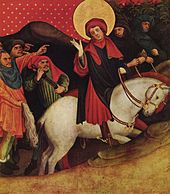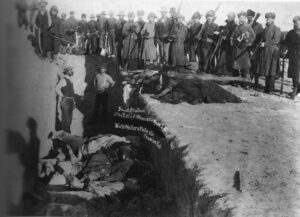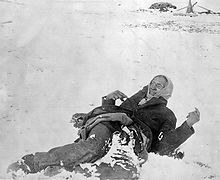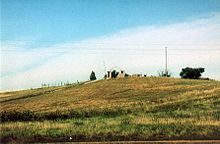On this day in 1170, Archbishop of Canterbury, saint and martyr, Thomas Becket, died in Canterbury Cathedral. Born c. 1118 in Cheapside, London. He is venerated as a saint and martyr by both the Roman Catholic Church and the Anglican Communion. Becket engaged in conflict with Henry II of England over the rights and privileges of the Church and was assassinated by knights loyal to the king. He was beatified 21 February 1173 and canonized by Pope Alexander III. St. Thomas’ feast day is 29 December.
The Final Footprint – Becket was entombed beneath the floor of the eastern crypt of the Canterbury Cathedral. A stone cover was placed over the burial place with two holes where pilgrims could insert their heads and kiss the tomb. In 1220, Becket’s bones were moved to a new gold-plated and bejewelled shrine behind the high altar in the Trinity Chapel. Canterbury, because of its religious history, had always seen a large number of pilgrims. However, after the death of Becket, the number of pilgrims visiting the city grew rapidly. The shrine was destroyed in 1538, around the time of the Dissolution of the Monasteries, on orders from King Henry VIII. The king also destroyed Becket’s bones and ordered that all mention of his name be obliterated. The pavement where the shrine stood is today marked by a lit candle. Reportedly, his bones were cremated and shot out of cannon over the city of Canterbury.
|
Mass grave for the dead Lakota after the massacre 150-300 killed: |
On this day in 1890 The Wounded Knee Massacre (also called the Battle of Wounded Knee) occurred near Wounded Knee Creek (Lakota: Čhaŋkpé Ópi Wakpála) on the Lakota Pine Ridge Indian Reservation in the U.S. state of South Dakota.
The previous day, a detachment of the U.S. 7th Cavalry Regiment commanded by Major Samuel M. Whitside intercepted Spotted Elk’s band of Miniconjou Lakota and 38 Hunkpapa Lakota near Porcupine Butte and escorted them 5 miles (8.0 km) westward to Wounded Knee Creek, where they made camp. The remainder of the 7th Cavalry Regiment, led by Colonel James W. Forsyth, arrived and surrounded the encampment. The regiment was supported by a battery of four Hotchkiss mountain guns.
On the morning of December 29, the U.S. Cavalry troops went into the camp to disarm the Lakota. One version of events claims that during the process of disarming the Lakota, a deaf tribesman named Black Coyote was reluctant to give up his rifle, claiming he had paid a lot for it. Simultaneously, an old man was performing a ritual called the Ghost Dance. Black Coyote’s rifle went off at that point, and the U.S. army began shooting at the Native Americans. The disarmed Lakota warriors did their best to fight back.
By the time the massacre was over, more than 150 men, women, and children of the Lakota had been killed and 51 were wounded (4 men and 47 women and children, some of whom died later); some estimates placed the number of dead at 300. Twenty-five army soldiers also died, and 39 were wounded (6 of the wounded later died). At least twenty soldiers were awarded the Medal of Honor. In 2001, the National Congress of American Indians passed two resolutions condemning the military awards and called on the U.S. government to rescind them.
The site of the battlefield/massacre has been designated a National Historic Landmark by the U.S. Department of the Interior. In 1990, both houses of the U.S. Congress passed a resolution on the historical centennial formally expressing “deep regret” for the massacre.
The Final Footprint
St. John’s Episcopal Mission Church was built on the hill behind the mass grave in which the victims had been buried, some survivors having been nursed in the then-new Holy Cross Mission Church. In 1903, descendants of those who died in the battle erected a monument at the gravesite. The memorial lists many of those who died at Wounded Knee along with an inscription that reads:
“This monument is erected by surviving relatives and other Ogalala and Cheyenne River Sioux Indians in memory of the Chief Big Foot massacre December 29, 1890. Col. Forsyth in command of US troops. Big Foot was a great chief of the Sioux Indians. He often said, ‘I will stand in peace till my last day comes.’ He did many good and brave deeds for the white man and the red man. Many innocent women and children who knew no wrong died here.”
The Wounded Knee Battlefield was declared a U.S. National Historic Landmark in 1965 and was listed on the U.S. National Register of Historic Places in 1966.
Beginning in 1986, the group named “Big Foot Memorial Riders” was formed to continue to honor the dead. The ceremony has attracted more participants each year and riders and their horses live with the cold weather, as well as the lack of food and water, as they retrace the path that their family members took to Wounded Knee. They carry with them a white flag to symbolize their hope for world peace, and to honor and remember the victims so that they will not be forgotten.
 On this day in 1894, poet Christina Rossetti died in Torrington Square, Bloomsbury, London at the age of 64. Born Christina Georgina Rossetti at 38 Charlotte Street (now 105 Hallam Street), London to Gabriele Rossetti, a poet and a political exile from Vasto, Abruzzo, and Frances Polidori, the sister of Lord Byron‘s friend and physician, John William Polidori. Rossetti wrote a variety of romantic, devotional, and children’s poems. Perhaps best known for her long poem Goblin Market, her love poem Remember, and for the words of the Christmas carol In the Bleak Midwinter.
On this day in 1894, poet Christina Rossetti died in Torrington Square, Bloomsbury, London at the age of 64. Born Christina Georgina Rossetti at 38 Charlotte Street (now 105 Hallam Street), London to Gabriele Rossetti, a poet and a political exile from Vasto, Abruzzo, and Frances Polidori, the sister of Lord Byron‘s friend and physician, John William Polidori. Rossetti wrote a variety of romantic, devotional, and children’s poems. Perhaps best known for her long poem Goblin Market, her love poem Remember, and for the words of the Christmas carol In the Bleak Midwinter.
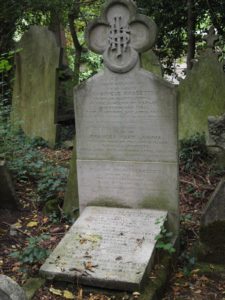
The Final Footprint – Rossetti is interred in Highgate Cemetery in London. Other notable final footprints at Highgate include; George Eliot, Karl Marx, and Jean Simmons.
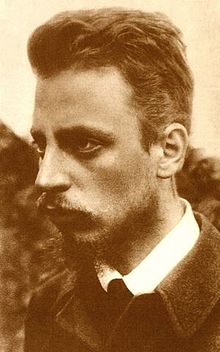 And on this day in 1926, poet and novelist Rainer Maria Rilke died in the arms of his doctor in the Valmont Sanatorium in Switzerland at the age of 51 from leukemia. Born René Karl Wilhelm Johann Josef Maria Rilke in Prague, capital of Bohemia (then part of Austria-Hungary, now the Czech Republic), on 4 December 1875. In my opinion, one of the most lyrically intense German-language poets. For me, Rilke’s work is inherently mystical. His writings include one novel, several collections of poetry, and several volumes of correspondence in which he invokes haunting images that focus on the difficulty of communion with the ineffable in an age of disbelief, solitude, and profound anxiety. These deeply existential themes tend to position him as a transitional figure between the traditional and the modernist writers. Rilke travelled extensively throughout Europe, including Russia, Spain, Germany, France, Italy, and in his later years settled in Switzerland. These settings were key to the genesis and inspiration for many of his poems. Perhaps best known for his contributions to German literature, over 400 poems were originally written in French and dedicated to the canton of Valais in Switzerland. Among English-language readers, his best-known works include the poetry collections Duino Elegies (Duineser Elegien) and Sonnets to Orpheus (Die Sonette an Orpheus), the semi-autobiographical novel The Notebooks of Malte Laurids Brigge (Die Aufzeichnungen des Malte Laurids Brigge), and a collection of ten letters that was published after his death under the title Letters to a Young Poet (Briefe an einen jungen Dichter). In the later 20th century, his work has found new audiences through its use by New Age theologians and self-help authors, and through frequent quoting in television programs, books and motion pictures.
And on this day in 1926, poet and novelist Rainer Maria Rilke died in the arms of his doctor in the Valmont Sanatorium in Switzerland at the age of 51 from leukemia. Born René Karl Wilhelm Johann Josef Maria Rilke in Prague, capital of Bohemia (then part of Austria-Hungary, now the Czech Republic), on 4 December 1875. In my opinion, one of the most lyrically intense German-language poets. For me, Rilke’s work is inherently mystical. His writings include one novel, several collections of poetry, and several volumes of correspondence in which he invokes haunting images that focus on the difficulty of communion with the ineffable in an age of disbelief, solitude, and profound anxiety. These deeply existential themes tend to position him as a transitional figure between the traditional and the modernist writers. Rilke travelled extensively throughout Europe, including Russia, Spain, Germany, France, Italy, and in his later years settled in Switzerland. These settings were key to the genesis and inspiration for many of his poems. Perhaps best known for his contributions to German literature, over 400 poems were originally written in French and dedicated to the canton of Valais in Switzerland. Among English-language readers, his best-known works include the poetry collections Duino Elegies (Duineser Elegien) and Sonnets to Orpheus (Die Sonette an Orpheus), the semi-autobiographical novel The Notebooks of Malte Laurids Brigge (Die Aufzeichnungen des Malte Laurids Brigge), and a collection of ten letters that was published after his death under the title Letters to a Young Poet (Briefe an einen jungen Dichter). In the later 20th century, his work has found new audiences through its use by New Age theologians and self-help authors, and through frequent quoting in television programs, books and motion pictures.
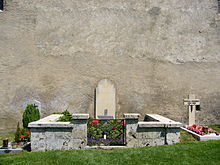 The Final Footprint – Rilke was interred on 2 January 1927 in the Raron cemetery to the west of Visp. Rilke had chosen as his own epitaph this poem:
The Final Footprint – Rilke was interred on 2 January 1927 in the Raron cemetery to the west of Visp. Rilke had chosen as his own epitaph this poem:
-
Rose, oh reiner Widerspruch, Lust,
Niemandes Schlaf zu sein unter soviel
Lidern.Rose, oh pure contradiction, delight
of being no one’s sleep under so
many lids.
A myth developed surrounding his death and roses. It was said: “To honour a visitor, the Egyptian beauty Nimet Eloui, Rilke gathered some roses from his garden. While doing so, he pricked his hand on a thorn. This small wound failed to heal, grew rapidly worse, soon his entire arm was swollen, and his other arm became affected as well”, and so he died.
#RIP #OTD in 2020 fasion designer Pierre Cardin died at the American Hospital of Paris, in Neuilly-sur-Seine, at the age of 98. Cimetière de Montmartre, Paris
#RIP #OTD in 2022 Brazilian professional footballer who played as a forward, widely regarded as one of the greatest players of all-time, Pelé died from colon cancer at Albert Einstein Israelite Hospital, São Paulo, aged 82. Cemitério Memorial Necrópole Ecumênica, Santos, São Paulo.
Have you planned yours yet?
Follow TFF on twitter @RIPTFF

